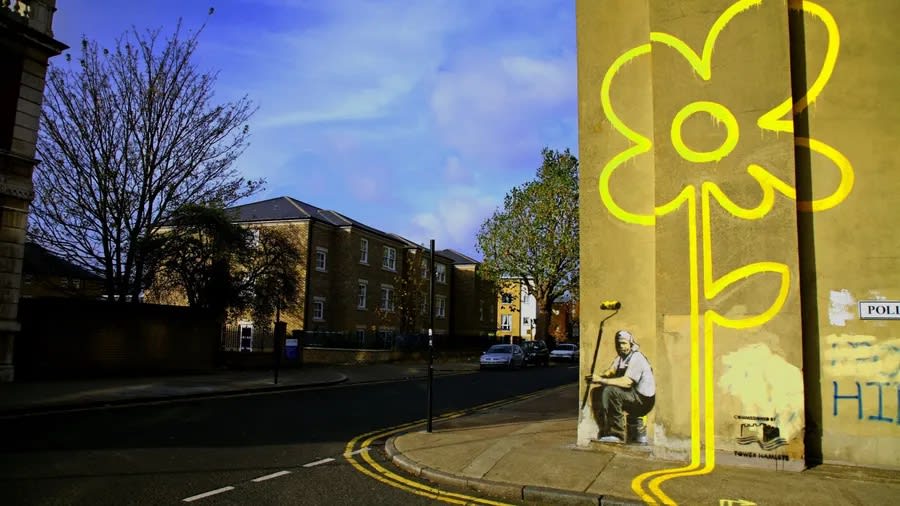
Image courtesy of Wallpaper.com
In the shifting landscape of contemporary art, few stories have stirred such intrigue as the saga of Banksy’s mural Yellow Lines Flower Painter. Once gracing the exterior of the Bethnal Green Working Men’s Club in East London, this 2007 work has re-emerged across the Atlantic, now the subject of a legal battle and an eye-watering insurance valuation. As of 2025, it is being shown in an Aspen, Colorado gallery with an insured value of $750,000—and a cloud of legal uncertainty hanging over it.
The mural depicts a weary council worker slumped beside paint cans, the bright yellow double lines he’s painted unfurling into a wild daisy. It’s classic Banksy: part satire, part poetry. Urban decay and beauty intertwine, as they so often do in his work. But what was once freely visible to passers-by in East London has now been chiselled from its original wall and shipped to the American market, allegedly without the full consent of the club that originally hosted it.
The story began in 2019, when Warren Dent, an events promoter linked to the Bethnal Green venue, allegedly purchased the mural for £20,000. He claimed the approval of then-secretary Stephen Smorthit. But in May 2025, three club trustees, Alan Milliner, Paul Le Masurier, and Kerry Smorthit (daughter of the secretary), filed a claim in the UK High Court, arguing that the sale and removal were unauthorised. They maintain that the artwork was never Dent’s to sell and should be returned to the club.
As the mural now hangs in a pristine gallery space far removed from its original gritty setting, the legal debate touches on wider questions: who owns street art? Can it be relocated, bought, and sold like any other artwork? And what happens when one of the most enigmatic artists of our time refuses to authenticate murals that have been removed from their intended context?
Banksy’s official authentication body, Pest Control, has long refused to certify any wall-based works that have been taken from their original sites. This makes resale a high-risk proposition. Without that certificate, auction houses like Christie’s or Sotheby’s, and reputable galleries such as Andipa, won’t touch them, and collectors are left navigating a legal grey zone.
For those hoping to buy a Banksy original painting or print, this story offers both a cautionary tale and a glimpse into the volatile power of the artist’s market. On the one hand, Yellow Lines Flower Painter—despite lacking Pest Control’s blessing, has been insured for three-quarters of a million dollars. On the other, it is now at the centre of a complex cross-border dispute, with trustees arguing that the mural was “stolen” from the community it was created for.
This is precisely why it is vital to work with established, reputable dealers when acquiring a Banksy work. Provenance is everything. In a market where questions of legality, authenticity and ownership are so often blurred, trusted expertise offers peace of mind and long-term value. For over 20 years, Andipa has been regarded as one of the world’s leading dealers in Banksy prints and original paintings, advising private collectors, institutions, and investors alike. Every work sourced by Andipa comes with rigorous due diligence, provenance checks and always with Pest Control certification.
Ethical questions abound. Is the mural more valuable in a private collection than on the side of a working men’s club in Tower Hamlets? Has its removal stripped it of meaning, or preserved it from decay? For Banksy, whose work has always danced on the boundary between resistance and commodification, the irony is palpable.
Yet collectors remain undeterred in buying original artworks by Banksy. With the artist’s more traditional studio pieces regularly selling for seven figures, such as Love is in the Air, there is always appetite for legal and certified paintings, signed and unsigned prints. For serious collectors or those exploring the Banksy market for the first time, provenance and due diligence have never been more essential. Documentation is as critical as the artwork itself. While some view such complexities as deterrents, others consider them part of the allure, knowledge, and negotiation.
As the case moves through the UK courts, the art world is watching. The outcome may set a precedent for how street art is treated in legal terms, not just in Britain but globally. Meanwhile, Yellow Lines Flower Painter remains in limbo, no longer public, not yet settled, and emblematic of the tensions at the heart of Banksy’s legacy.
For those seriously interested in buying a Banksy, this tale is a timely reminder: authenticity, legality, and context all matter. Whether it’s a print, a painting, or sculpture, the value of a Banksy lies not only in the image, but in the story that surrounds it and the supportuning documentation and expertise. When in doubt, trust experience, and buy from those who know the artist's work, and the art market inside out.
For further reading take a look at the news-breaking article at the Financial Times (FT): https://www.ft.com/content/48e5ffb2-0eff-45eb-b41e-5bd7a879f0e2?utm_source=chatgpt.com
